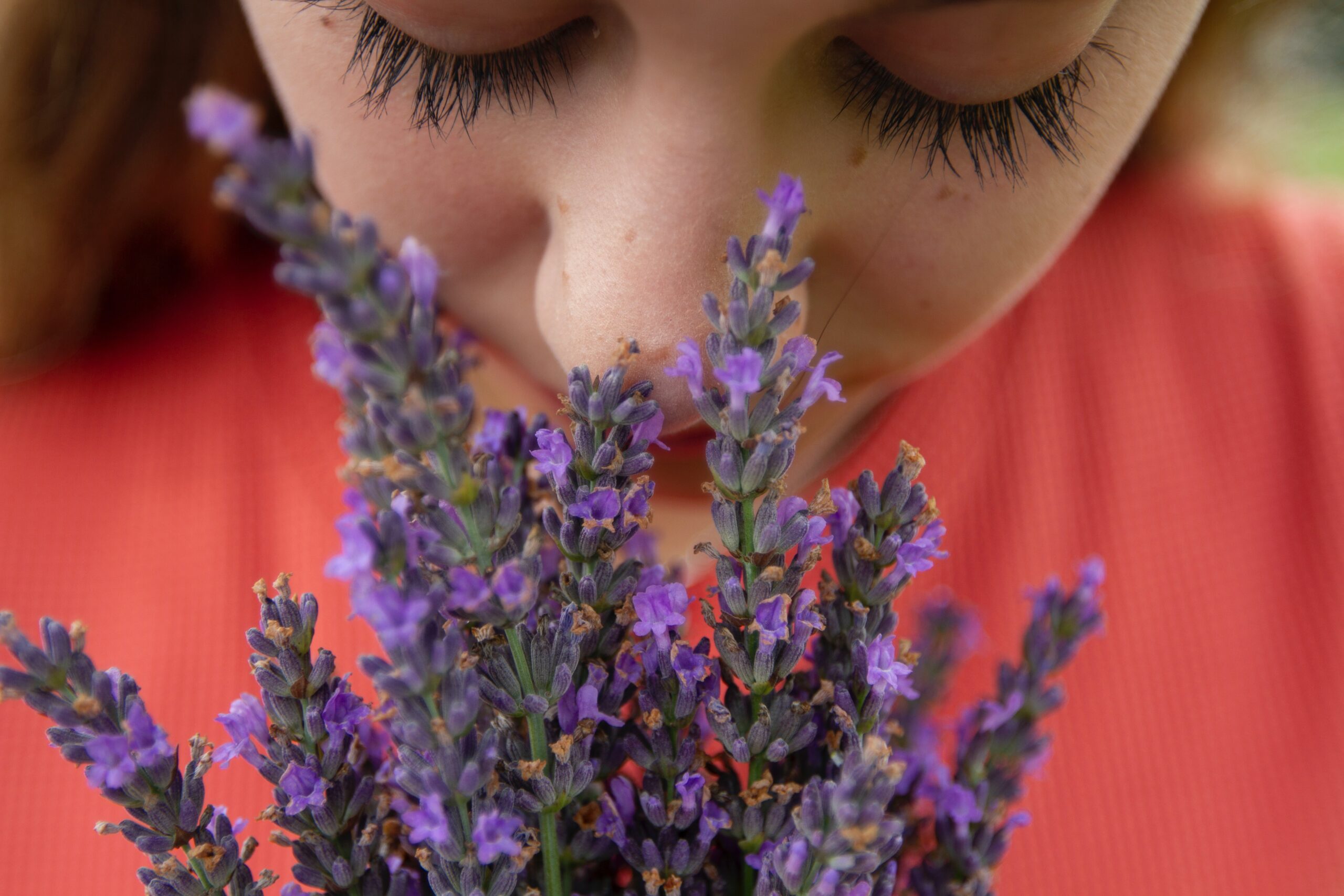What is olfactory training?
Olfactory training, also known as smell training, is a therapeutic technique designed to enhance and restore the sense of smell. This method gained popularity as a supportive measure for individuals experiencing anosmia (total loss of smell) or hyposmia (reduced sense of smell). Olfactory training involves regularly exposing oneself to a variety of distinct scents, typically through the use of fragrance sources. By consistently stimulating the olfactory system, individuals aim to retrain their sense of smell and improve their ability to detect and distinguish different odors.
This approach is often recommended for those recovering from respiratory infections, such as the common cold or COVID-19, which can temporarily impact the sense of smell. Olfactory training is a non-invasive and accessible method that can be practiced at home, offering hope to those seeking to regain their olfactory abilities. Integrating olfactory training into daily routines may contribute to a gradual improvement in smell perception and overall olfactory function.
Why is olfactory training important?
Olfactory training holds immense importance for individuals grappling with anosmia or a diminished sense of smell. This therapeutic technique involves regular exposure to various scents to stimulate and retrain the olfactory system. Anosmia, often a consequence of respiratory infections like COVID-19, can significantly impact one’s quality of life, affecting taste perception and diminishing the ability to detect potential dangers, such as spoiled food or gas leaks.
Engaging in olfactory training is crucial for facilitating the recovery and improvement of the sense of smell. Consistent exposure to diverse odors helps the brain adapt and regain its ability to recognize and differentiate scents. This non-invasive and accessible approach empowers individuals to take an active role in their sensory rehabilitation, offering a glimmer of hope for those experiencing olfactory challenges. By incorporating olfactory training into daily routines, individuals can potentially enhance their olfactory function and regain a fuller, more enriching sensory experience. Invest in olfactory training to unlock the doors to a world of scents and flavors, promoting overall well-being.
Causes of reduced sense of smell
An impaired sense of smell can be caused by several factors and can lead to temporary or permanent loss of the sense of smell. For proper diagnosis and treatment, it is important to seek medical help and continuously train the sense of smell using olfactory training.
COVID-19
The reduced sense of smell, or anosmia, has emerged as a significant symptom associated with COVID-19. This viral infection caused by the SARS-CoV-2 virus has been linked to a temporary loss of the sense of smell in many affected individuals. The exact mechanism is not fully understood, but it is believed that the virus may directly impact the olfactory nerve or affect the supporting cells in the nasal cavity.
The consequences of anosmia extend beyond mere inconvenience, as it can impact one’s ability to taste, affecting overall enjoyment of food and beverages. This symptom, often accompanied by other respiratory issues, underscores the importance of recognizing COVID-19’s diverse range of manifestations. While anosmia is typically temporary, engaging in olfactory training has emerged as a recommended strategy to expedite recovery. Understanding the causes of a reduced sense of smell becomes crucial for comprehensive health awareness and management.
Medical conditions
Hormonal imbalances can affect the sense of smell as hormones play an important role in regulating our sensory system. When hormones are imbalanced, it can affect the mucous membranes in the nose, thereby impairing the sense of smell. Some neurological diseases, including Alzheimer’s and Parkinson’s, involve degeneration of nerve cells in the brain, which can affect the parts of the brain responsible for the sense of smell. This damage can result in loss of the sense of smell.
Certain medications, including some cancer treatments such as chemotherapy and some nasal sprays used to treat allergies, can also negatively affect the sense of smell. Chemotherapy drugs and other strong medications can damage the odor receptors in the nose. At the same time, some nasal sprays contain substances that can irritate the mucous membranes of the nose and lead to impaired sense of smell.
Injuries & trauma
Injury and trauma can have a significant impact on the sense of smell and lead to anosmia or impaired olfactory function. Damage to nasal structures, including nasal cartilage, mucous membranes, and olfactory receptors, can occur in head injuries and traumatic events. When these tissues are damaged or swollen due to trauma, it can block the flow of air through the nose and prevent scent molecules from reaching the olfactory cells located high up in the nose. In addition, direct trauma to the head can lead to damage to the parts of the brain responsible for processing odor impressions. Head injuries can also cause inflammation in the brain, which can affect its ability to correctly interpret scent signals.
Trauma-related anosmia can be immediate or develop over time as a result of ongoing injury or inflammation. The severity of the injury often correlates with the extent of the odor impairment. It is important to seek prompt medical attention after a head injury to assess and address any damage to the olfactory system.
The basics for training your sense of smell
Olfactory training has become increasingly popular and recognized as an effective way to improve the ability to smell. The sense of smell plays a crucial role in our ability to experience and enjoy different scents and flavors. There are several reasons why you should consider training your sense of smell.
- Loss of the sense of smell can be a side effect of various medical conditions such as nasal polyps, sinus diseases, and diseases such as COVID-19. Olfactory training has been shown to be effective in stimulating the olfactory receptors and promoting recovery of lost olfactory abilities.
- Training the sense of smell improves the experience of food and drink by enhancing flavors. It can also help to increase awareness of your surroundings and experience different scents in a deeper way.
- Through regular exercise and exposure to different scents, you can strengthen your sense of smell and benefit from its many advantages for your health and quality of life

The theory behind olfactory training
Olfactory training is based on the fascinating principle of neuroplasticity, which is the brain’s amazing capacity to reorganize itself by creating new neural connections. When we regularly expose our olfactory receptors to different scents, a complex process takes place in the brain. Each time we inhale a scent, our olfactory receptors send signals to the brain, and repeated exposures create new neural pathways and connections in our olfactory system.
This adaptability is the key to the success of olfactory training. By training the sense of smell regularly and consciously exposing oneself to different scents, the different areas of the brain responsible for the sense of smell are stimulated. This not only strengthens existing connections but also creates new ones, resulting in improved scent discrimination and the ability to identify subtle nuances in scents.
By activating and challenging our olfactory system in this way, we can not only recover lost olfactory abilities, for example after an illness, but also improve and enrich our overall olfactory experience. This scientifically proven method shows how wonderfully adaptable our brain is and how we can maximize our olfactory abilities through training regimes and consistent exposure to different scents.
Smell training from NOSA
NOSA has developed a smell training kit that is easier to use, more effective than other methods, and also provides a faster treatment for those with reduced ability to smell. The product is developed together with some of the world’s leading odor researchers from Karolinska Institutet.
Why you should choose Nosa’s smell training
CE-marked
NOSA smell training is a CE-marked smell training product. The product is a medical device, which means that it has been tested by the Medical Devices Directive. This includes, for example, that the manufacturer ensures that the product is not harmful and that it has the indicated effect. This is a mark of quality and distinguishes the product from other odor training methods where many fragrances actually contain allergens, carcinogens and other harmful substances. NOSA’s products avoid this.
2 months treatment
Smell training with NOSA’s smell training kit involves a significantly shorter treatment than other methods. Previous, simpler, methods such as smelling spices or aromatic oils are generally not very effective and the treatment time is therefore often between 3-9 months. With NOSA’s smell training, the treatment takes place in 2 months, allowing more people to be helped faster.
High level of compliance
An important aspect of NOSA’s smell training is that more people actually manage to complete the entire treatment. A big problem with previous treatment methods is that they are very demanding; you have to sit down and smell cans and oils every morning and evening for 3-9 months, which is such a big restriction in everyday life that many people simply cannot cope and therefore do not complete their smell training. With NOSA smell training, you can do smell training when you want and where you want, at the same time as you can easily schedule and plan in the interactive app.
Nosa’s scents
NOSA smell training comes with 10 scented noseplugs that are easy to breathe through; Lemon, Strawberry, Orangea, Vanilla, Melon, Rosemary, Lavender, Menthol, Cherry, and Cola. Fruity and spicy fragrances are to be recommended for a smell training program.

Strawberry

Orange

Vanilla

Cherry

Lemon

Menthol

Cola

Melon

Rosemary

Lavender
How to do smell training
Smell training involves following a predetermined schedule of smell training twice in the morning and twice in the afternoon. This is repeated five days a week for a total of 8 weeks. Each scent plug should be used for 10 minutes at a time and can be done at the same time as other activities.
Since a loss of smell is due to nerve impulses between the olfactory bulb and the brain not going through correctly, it is important to stimulate both from the nerves in the nose – by exposing yourself to the smells, but equally important is to activate the signals between the brain and the receptors. You do this by associating previous experiences with the scent in question. For example, smelling a lemon scent can help if you think about previous situations where you have smelled the scent and how sour it was. It can also be beneficial to visualize the scent, such as what a lemon looks like, or how it feels in your hand.
Smell training app from NOSA
NOSA has also developed a smell training app to help you plan, schedule, give reminders, and motivate you in your smell training. It is also possible to give feedback and see how you have rated the different scents over time. You can also get tips and answers to common questions that may arise during smell training.
Passive olfactory training
NOSA smell training is an odor training method based on passive smell training. Previously, there has been a lot of focus on the user being as active as possible in their smell training, but at the same time, it is the same reason why so many people do not manage to complete the smell training.
Passive smell training is a new concept that allows you to train while doing other things. This is made possible by the unique and patented design of Nosa’s scented nose plugs, which means that you only need to insert them into your nose and then you can do other things while you smell train. Whether you’re cooking, sitting in a meeting, or watching a movie, you can now easily smell-train.

Preparation for smell training
Successful smell training requires commitment and patience, as results do not necessarily come overnight. It is also important to keep a positive attitude and not be discouraged by temporary difficulties.
Material
Invest in high-quality smell training kits to ensure authentic scent experiences. A smell training kit is an indispensable tool for those who want to improve their sense of smell. These kits are specially designed to offer a varied experience and enable targeted training.
The scents
To be successful with olfactory training, the scents should be authentic and clear to facilitate training, especially for beginners. Create a calm and scent-neutral training environment to minimize external distractions and focus on the sense of smell.
Your current state
It is important that you feel relaxed and focused for the best possible results. It is beneficial to avoid odor training when you are tired or stressed as this can affect your ability to concentrate and perceive scents correctly. A steady and positive attitude is also essential to maintain motivation and stamina during training. By creating a calm and positive atmosphere, the individual can maximize the benefits of olfactory training and increase the chances of success.

How to start your olfactory training – Step-by-step guide
NOSA smell training is expected to be much more effective than traditional smell training and shortens the training time to 2 months due to its ability to ”train on the go” with effective nose plugs.
Step 1
Always start by washing your hands. This ensures that you avoid possible irritation or infection.
Step 2
Take out the first two scents according to the calendar and gently insert the first scented plug into the nose. Gently apply in the nostrils until the attachment meets the nasal wall.
Step 3
Set a timer for 10 minutes. During this time, focus on the scent. Visualization can help reinforce your memory of the scent.
Step 4
Once the first session is complete, gently remove the product from your nose and repeat steps 1-3 with the next scent according to the calendar.
Step 5
Follow the same steps for the evening session. This is repeated five days a week for 8 weeks. Track the results in the app


